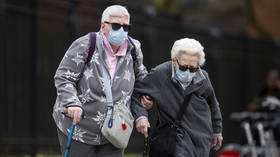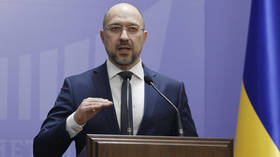As a GP, I fear our Covid-19 lockdown will result in significantly more deaths than we are trying to prevent
We are paying too high a price to try to combat Covid-19. Not just in terms of the £350 billion ($430 billion) bill, but also in the health costs our actions are causing.
The Covid-19 pandemic has brought a very thorny issue to the forefront. How much money can we, as a society, spend on keeping people healthy or alive? No one has ever fully got to grips with this question, but it has never been more important than now.
America has set aside $2 trillion to deal with the crisis, and Britain £350 billion – which is almost three times the current yearly budget for the entire NHS. Is this a price worth paying?
Many people will instantly dismiss such a question as being coldhearted or stupid: "You cannot put a value on a human life" is an argument I have heard many times, whenever health economics is discussed.
The counter-argument is that, if funds are not limitless (which they aren’t and can’t be), then we must focus on funding things that do the greatest good. This is why the National Institute for Health and Care Excellence (NICE) was established.
NICE reviews interventions and decides if they provide value for money. The economic term for this is cost-effectiveness. It is complex and often relies on assumptions that can be difficult to verify.
However, to keep things (relatively) simple, NICE attempts to compare healthcare interventions against each other by using a form of “currency” called the cost per QALY. A QALY is a Quality Adjusted Life Year. One added year of completely healthy life is one QALY.
People with conditions such as cancer, or severe heart disease, or who are suffering from chronic pain, can be considered to have a quality of life less than one. We can say that their quality of life is, say, 50 percent. Thus, one year of additional life gained for them has a value of 0.5 of a QALY.
Not everything that is measured using a QALY relates to saving, or extending, lifespan. For example, someone could have chronic hip pain, and a quality of life of 0.5. A hip replacement may remove the pain, and their quality of life will improve from 0.5 to 1. If they live another 20 years, they will have gained 20 x 0.5 QALYs = 10 QALYs.
Whichever way you look at QALYs, the fundamental question always comes down to 'How much can we afford to pay for one QALY?' In the UK, the current answer is that NICE recommends interventions which cost less than £30,000 ($36,933) per QALY.
This figure can vary. Interventions for young children tend to receive more per QALY, and powerful lobbying groups can bring pressure to bear on that figure. However, £30,000 is generally accepted – if not widely publicized.
Therefore, if we are willing to spend £350 billion ($430 billion) on managing coronavirus, how many QALYs do we hope to get back? The simple answer is to divide £350 billion by 30,000 = 11,666,666 QALYs.
(For those who think this an impossible or inhuman calculation, you need to consider how many other lives could be saved, how much other suffering or death could be prevented, by spending £350 billion in other ways.)
Are we likely to achieve this level of benefit? Of course, any attempt to model this requires several assumptions to be made. However, the model here only has four variables, two of which are (pretty much) known. They are:
- How many people will die?
- What is the average age of death?
- What is the average reduction in life expectancy in those who die?
- What is the average quality of life of those who die?
So, for example:
- 500,000 die (based on the upper level of the Imperial College study)
- Average age at death 78.5 (based on figures taken from Covid deaths in Italy)
- Average reduction in life expectancy three years (based on modeling of life expectancy)
- Average quality of life of those who die 0.7 (based on studies done to work out the “reported” quality of life in those with multi-morbidity)
We get 500,000 x 3 x 0.7 = 1,050,000 QALYs lost.
Using these figures, spending £350 billion to reduce the “QALYs lost” figure to zero means that each QALY will have cost £333,000 ($410,000), more than 10 times the NICE level. And, if the death toll does not reach the 500,000 upper estimate, then the cost per QALY will be even higher.
People will immediately object to this calculation. How do we know how many will die? How can we be certain about the average quality of life of those who die or the average reduction in life expectancy?
All I can say is that these calculations, while complex, are based on robust statistical data. However, it is usually best to input different figures to outline best and worst cases, to look at more than one scenario. So, were we to stick using the upper limit of 500,000, but adjust the average life expectancy gained to 4.5 years and the average quality of life to 0.8, you get: 500,000 x 4.5 x 0.8 = 1,800.000 QALYS. The cost per QALY then becomes: £194,444 ($239,397) [£350 billion ÷ 1.8 million]
Also on rt.com Doctors are sending out ‘do-not-resuscitate’ forms telling people like my disabled daughter to sign them, I find that chillingI fully recognize that looking at human life from an economic perspective can seem harsh, almost inhumane. Can we really stand back and watch an elderly person “drown” as their lungs fill up with fluid, and say “Sorry, we are not spending money on more ventilators, because it is not cost-effective”?
However, it is not straightforward. There are currently deaths, and disability, directly caused by shifting virtually the entire focus of the health service towards Covid-19.
Hip replacements are also being postponed and other, hugely beneficial interventions are not being done. Those with heart disease and diabetes are not being treated. People are not having operations that they would have. Many are not immediately lifesaving, but cancer patients are not receiving chemotherapy. Those awaiting implantable defibrillators are not having them – and some will die as a result.
Elderly people, with no support, may simply die of starvation in their own homes. Jobs will be lost, companies are going bust, suicides will go up. Psychosocial stress will be immense.
I care for patients in intermediate care, two of whom we sent to hospital last week, with non-Covid related illness. They were both sent straight back, they both died. They were elderly, they were ill, but in normal circumstances they would have been admitted and, hopefully, successfully treated.
Ambulance crews have been instructed to keep people at home, or in care homes, if at all possible. Some of them will die as a result. These are what I call the ‘because of Covid-19’ related deaths.
Then there are those abused women, and children, trapped at home with their abusers.
In short, this is very much not a zero-sum game of life saved v money. There is significant harm being done. Longer-term harms will inevitably occur from job losses, loss of income, and suchlike. Economy and health do not exist in isolation.
This was highlighted in a study of two areas of Glasgow in 2008. One Lenzie, which was rich; the other Calton, was poor and socially deprived. The findings were stark: a life expectancy of 54 for men in Calton, compared with 82 in Lenzie.
A 28-year difference in life expectancy between people living approximately five miles apart. The difference? Wealth, money, economics. If we severely damage the economy, this will have enormous effects on health and wellbeing, possibly for decades.
Are we paying too much to lock-down Covid? The answer from most people may well be that "I don’t care, we need to spend as much as it takes." My fear is that, if we are not very careful, the actions we are taking will result in significantly more deaths than we are trying to prevent.
Even if we restrict the analysis purely to the cost per QALY and narrow the ‘health’ analysis purely to Covid, and deaths from Covid, it remains difficult to justify spending £350 billion to control a single disease.
I know that many people will violently disagree with this analysis and will think I am some coldhearted fiend. "People are dying, we must do absolutely everything we can. No matter how much it costs." "What would you say if it was your mother…" and suchlike.
Well, I have spoken to my mother, who is 92. Her view is that she has lived long enough. She thinks the government actions are a ridiculous over-reaction. She is going out shopping and chatting to friends… she will take no advice on the matter.
So, what would I do if it was my mother that was dying? I would say that she made her choice, and who am I to argue with it.
This article is an abridged version of a blog by Dr Malcolm Kendrick, which was written to help inform a debate on the wider implications of the current UK strategy on dealing with Covid.
The statements, views and opinions expressed in this column are solely those of the author and do not necessarily represent those of RT.
















